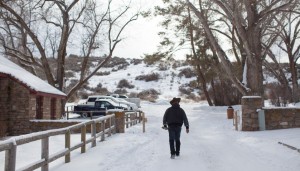
An anti-government occupier strolls by his New Deal-era shelter. Source
Photo Credit: Rob Kerr/Getty Images NARRATIVE CONTENT GROUP, 2016
The Malheur National Wildlife Refuge has been much in the news lately. It is the site of an armed standoff between a group of western ranchers and the US Fish and Wildlife Service. The conservative militants and their supporters are angry at the government’s perceived mistreatment of two local ranchers at the hands of the federal government (Mother Nature Network has a good run-down of the situation). Ironically, for a movement staking its claim on individual property rights and limited government, the occupiers owe their current shelter in snowy Oregon and, it seems, their “media center” to the greatest federal program ever undertaken in the United States: the New Deal.
As several Living New Deal team members noticed right away, Malheur National Wildlife Refuge is a New Deal site that has been up on our map for some time. In 1908, President Theodore Roosevelt, backed by the Oregon Audubon Society, established the Malheur refuge on unclaimed government lands to serve “as a preserve and breeding ground for native birds” who were being killed in droves by plume hunters working for the hat industry. A generation later, under the administration of Roosevelt’s fifth cousin, Franklin, the Civilian Conservation Corps (CCC) expanded the refuge, constructing dams, bridges, and roads, and erecting a number of handsome buildings that remain on the grounds.
The occupation of The Malheur National Wildlife Refuge has been approached from many angles: Aaron Bady’s analysis of the role of historical narration in the militia’s rhetoric and propaganda; debates about a “racial double standard” in the law’s treatment of the occupiers; and Charles Mudede’s meditations on class and the exploitation of labor, to name just a few. But it’s worth noting another dimension of current events: The New Deal’s legacy is everywhere and its structures (as well as its lessons) are all-too-easily overlooked and forgotten.